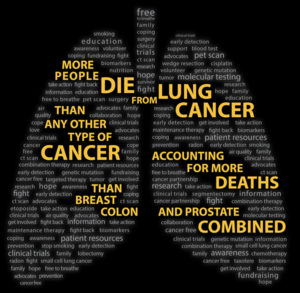Understanding if and where lung cancer has spread (the stage) is important to determining what options are available for treatment. Imaging tests, biopsies and laboratory tests help to determine staging.
Non-Small Cell Lung Cancer
Non-small cell lung cancer is one of several cancers staged using the TNM system. The cancer is staged according to the size of the tumor (T), the extent to which the cancer has spread to the lymph nodes (N), and the extent to which the cancer has spread beyond the lymph nodes, or metastasis (M).
How Does The TNM Staging System Work?
The TNM staging system:
- Was created by merging the staging systems of the American Joint Committee on Cancer (AJCC) http://www.cancerstaging.org/ and the International Union Against Cancer (UICC) http://www.uicc.org/ in 1987
- Is one of the most commonly used cancer staging systems
- Standardizes cancer staging internationally
T is for Tumor
How big is the tumor? Where is it located? Has it spread to nearby tissue?
| TX | The primary tumor cannot be assessed, or the presence of a tumor was only proven by the finding of cancer cells in sputum or bronchial washings but not seen in imaging tests or bronchoscopy. |
| T0 | No evidence of a primary tumor. |
| Tis | “In situ” – cancer is only in the area where the tumor started and has not spread to nearby tissues. |
| T1 | The tumor is less than 3 cm (just slightly over 1 inch), has not spread to the membranes that surround the lungs (visceral pleura), and does not affect the air tunes (bronchi) that brand out on either side from the windpipe (trachea). |
| T1a | The tumor is less than 2 cm. |
| T1b | The tumor is larger than 2 cm but less than 3 cm. |
| T2 | The tumor is larger than 3 cm but less than 7 cm or involves the main air tubes (bronchus) that brand out from the windpipe (trachea) or the membranes that surround the lungs (visceral pleura). The tumor may partially block the airways but has not caused the entire lung to collapse (atelectasis) or to develop pneumonia). |
| T2a | The tumor is larger than 3 cm but less than or equal to 5 cm. |
| T2b | The tumor is larger than 5 cm but less than or equal to 7 cm. |
| T3 | The tumor is more than 7 cm or touches an area near the lung (such as the chest wall or diaphragm, or sac surrounding the heart (pericardium) or has grown into the main air tubes (bronchus) that brand out from the windpipe (trachea) but not the area where the windpipe divides or has caused one lunch to collapse (atelectasis) or pneumonia in an entire lung or there is a separate tumor(s) in the same lobe. |
| T4 | The tumor is of any size and has spread to the area between the lungs (mediastinum), heart, trachea, esophagus, backbone or the place where the windpipe (trachea) branches or there is a separate tumor(s) in a different lobe of the same lung. |
N is for Lymph Node
Has the cancer spread to the lymph nodes in and around the lungs? For more information on the lymph system and lymph nodes, see Lymph System
| NX | Regional lymph nodes cannot be assessed. |
| N0 | No cancer found in lymph nodes. |
| N1 | Cancer has spread to lymph nodes within the lung or to the area where the air pipes (bronchus) that branch out from the windpipe enter the lung, but only on the same side of the lung as the tumor (ipsilateral). |
| N2 | Cancer has spread to lymph nodes near where the windpipe (trachea) branches into the left and right air tubes (bronchi) or near the area in the center of the lung (mediastinum) but only on the same side of the lung as the tumor. |
| N3 | Cancer has spread to lymph nodes found on the opposite side of the lung as the tumor (contralateral) or lymph nodes in the neck. |
M is for Metastasis
Has the cancer spread to other parts of the body?
| MX | Cancer spread cannot be assessed |
| M0 | Cancer has not spread. |
| M1 | Cancer has spread. |
| M1a | Cancer has spread: separate tumor(s) in a lobe in the opposite lung from the primary tumor (contralateral), or malignant nodules in the membrane that surround the lung (pleura) or malignant excess fluid (effusion) in the pleura or membrane that surround the hear (pericardium). |
| M1b | Cancer has spread to distant part of the body such as brain, kidney, bone. |
Stages
After the Tumor (T), Lymph Nodes (N) and Metastasis (M) have been determined, the cancer is then staged accordingly:
| Overall Stage | T | N | M |
|---|---|---|---|
| Stage 0 | Tis (in situ) | N0 | M0 |
| Stage IA | T1a, b | N0 | M0 |
| Stage IB | T2a | N0 | M0 |
| Stage IIA | T1a, b T2a T2b |
N1 N1 N0 |
M0 M0 M0 |
| Stage IIB | T2b T3 |
N1 N0 |
M0 M0 |
| Stage IIIA | T1, T2 T3 T4 |
N2, N1 N2, N0 N1 |
M0 M0 M0 |
| Stage IIIB | T4 Any T |
N2 N3 |
M0 M0 |
| Stage IV | Any T | Any N | M1a, b |
Small Cell Lung Cancer
Small cell lung cancer is most often staged as either limited-stage or extensive-stage.
Limited-Stage
Indicates that the cancer has not spread beyond one lung and the lymph nodes near that lung.
Extensive-Stage
The cancer is in both lungs or has spread to other areas of the body.
Source:
International Association for the Study of Lung Cancer. Goldstraw P, ed. Staging Handbook in Thoracic Oncology. Orange Park: Editorial Rx Press; 2009.

